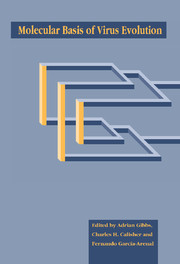Book contents
- Frontmatter
- Contents
- List of contributors
- Editors' preface
- Conference participants
- 1 Introduction and guide
- Part I The impact of viral diseases
- Part II Origins of viruses and their genes
- Part III Sources of virus variation
- Part IV Molecular interactions of viruses and their hosts
- Part V Viruses, hosts and populations
- 13 Quasi-species: the concept and the word
- 14 The co-evolutionary dynamics of viruses and their hosts
- 15 Population genetics of viruses: an introduction
- 16 Origin and evolution of prokaryotes
- 17 Molecular systematics and seed plant phylogeny: a summary of a parsimony analysis of rbcL sequence data
- Part VI Case studies of viral taxa; their systematics and evolution
- Part VII Techniques for viral systematics
- Index
16 - Origin and evolution of prokaryotes
Published online by Cambridge University Press: 04 May 2010
- Frontmatter
- Contents
- List of contributors
- Editors' preface
- Conference participants
- 1 Introduction and guide
- Part I The impact of viral diseases
- Part II Origins of viruses and their genes
- Part III Sources of virus variation
- Part IV Molecular interactions of viruses and their hosts
- Part V Viruses, hosts and populations
- 13 Quasi-species: the concept and the word
- 14 The co-evolutionary dynamics of viruses and their hosts
- 15 Population genetics of viruses: an introduction
- 16 Origin and evolution of prokaryotes
- 17 Molecular systematics and seed plant phylogeny: a summary of a parsimony analysis of rbcL sequence data
- Part VI Case studies of viral taxa; their systematics and evolution
- Part VII Techniques for viral systematics
- Index
Summary
Introduction
Genealogical relationships among prokaryotes have traditionally been defined by very diverse morphological, physiological and biochemical properties as well as by immunological comparisons of a few proteins. The main problems in interpreting the results of this deductive approach come from uncertainty about whether or not these characters are actually homologous. These genealogies can only be verified by inductive methods such as the analysis of palaeochemical data, the identification of fossils and the determination of the order of their appearance in time, and also by the biochemical investigation of the genes of ubiquitously distributed macromolecules that have conserved primary and secondary structure and functional constancy. In contrast to geological and fossil evidence, analyses of macromolecules offer an almost unlimited source of invaluable information about the genealogy of living organisms (Zuckerkandl & Pauling, 1965). In particular, estimation of the natural relationships among organisms presently alive can be by sequence analysis of ribosomal (r)RNAs and their genes, genes coding for certain enzymes (ATPases) and regulatory proteins (tuf-factors), and by nucleic acid hybridization studies. These methods are able to span the full range of relationships, from the hypothetical ancestor of life on earth to most recently evolved strains. In his superb reviews Woese (1987, 1991) discussed the rationale for using rRNA as a molecular clock in phylogenetic studies, rather than the traditional classification system which failed to delineate phylogenetic relationships, and discussed the power of sequences and nucleotide signatures to unravel phylogenetic trees.
- Type
- Chapter
- Information
- Molecular Basis of Virus Evolution , pp. 224 - 242Publisher: Cambridge University PressPrint publication year: 1995



